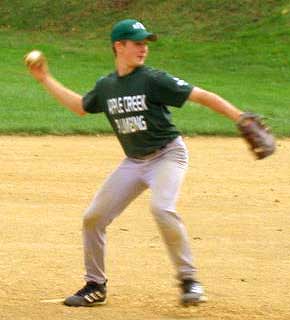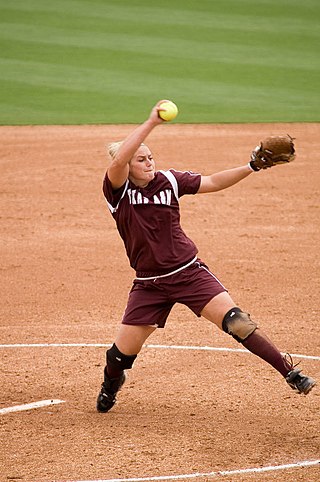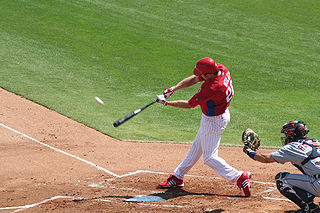
Running is a method of terrestrial locomotion by which humans and other animals move rapidly on foot. Running is a gait with an aerial phase in which all feet are above the ground. This is in contrast to walking, where one foot is always in contact with the ground, the legs are kept mostly straight, and the center of gravity vaults over the stance leg or legs in an inverted pendulum fashion. A feature of a running body from the viewpoint of spring-mass mechanics is that changes in kinetic and potential energy within a stride co-occur, with energy storage accomplished by springy tendons and passive muscle elasticity. The term "running" can refer to a variety of speeds ranging from jogging to sprinting.

Recoil is the rearward thrust generated when a gun is being discharged. In technical terms, the recoil is a result of conservation of momentum, as according to Newton's third law the force required to accelerate something will evoke an equal but opposite reactional force, which means the forward momentum gained by the projectile and exhaust gases (ejectae) will be mathematically balanced out by an equal and opposite momentum exerted back upon the gun.

In baseball, the pitcher is the player who throws ("pitches") the baseball from the pitcher's mound toward the catcher to begin each play, with the goal of retiring a batter, who attempts to either make contact with the pitched ball or draw a walk. In the numbering system used to record defensive plays, the pitcher is assigned the number 1. The pitcher is often considered the most important player on the defensive side of the game, and as such is situated at the right end of the defensive spectrum. There are many different types of pitchers, such as the starting pitcher, relief pitcher, middle reliever, lefty specialist, setup man, and the closer.

In baseball and softball, the curveball is a type of pitch thrown with a characteristic grip and hand movement that imparts forward spin to the ball, causing it to dive as it approaches the plate. Varieties of curveball include the 12–6 curveball, power curveball, and the knuckle curve. Its close relatives are the slider and the slurve. The "curve" of the ball varies from pitcher to pitcher.

A strike is a directed, forceful physical attack with either a part of the human body or with a handheld object, intended to cause blunt or penetrating trauma upon an opponent.

A four-seam fastball, also called a rising fastball, a four-seamer, or a cross-seam fastball, is a pitch in baseball. It is a member of the fastball family of pitches and is usually the fastest ball thrown by a pitcher. It is called what it is because with every rotation of the ball as it is thrown, four seams come into view. A few pitchers at the major league level can sometimes reach a pitch speed of over 100 mph. It is often compared with the two-seam fastball.

Equine conformation evaluates a horse's bone structure, musculature, and its body proportions in relation to each other. Undesirable conformation can limit the ability to perform a specific task. Although there are several faults with universal disadvantages, a horse's conformation is usually judged according to its intended use. Thus "form to function" is one of the first set of traits considered in judging conformation. A horse with poor form for a show jumper could have excellent conformation for a cutting horse or draft horse. Every horse has good and bad points of conformation and many horses excel even with conformation faults.
In the sport of cricket, the bowling action is the set of movements that result in the bowler releasing the ball in the direction of the batsman.

Motion, the process of movement, is described using specific anatomical terms. Motion includes movement of organs, joints, limbs, and specific sections of the body. The terminology used describes this motion according to its direction relative to the anatomical position of the body parts involved. Anatomists and others use a unified set of terms to describe most of the movements, although other, more specialized terms are necessary for describing unique movements such as those of the hands, feet, and eyes.

In baseball, sidearm is a motion for throwing a ball along a low, approximately horizontal plane rather than a high, mostly vertical plane (overhand).

Little League elbow, technically termed medial epicondyle apophysitis, is a condition that is caused by repetitive overhand throwing motions in children. "Little Leaguer's elbow" was coined by Brogdon and Crow in an eponymous 1960 article in the American Journal of Radiology.

Fastpitch softball, or simply fastpitch, is a form of softball played by both women and men. While the teams are most often segregated by sex, coed fast-pitch leagues also exist. Considered the most competitive form of softball, fastpitch is the format played at the Olympic Games. Softball was on the International Olympic Committee (IOC) program in 1996, 2000, 2004, 2008, and 2020.

The leg raise is a strength training exercise which targets the iliopsoas. Because the abdominal muscles are used isometrically to stabilize the body during the motion, leg raises are also often used to strengthen the rectus abdominis muscle and the internal and external oblique muscles.

Sprinting involves a quick acceleration phase followed by a velocity maintenance phase. During the initial stage of sprinting, the runners have their upper body tilted forward in order to direct ground reaction forces more horizontally. As they reach their maximum velocity, the torso straightens out into an upright position. The goal of sprinting is to reach and maintain high top speeds to cover a set distance in the shortest possible time. A lot of research has been invested in quantifying the biological factors and mathematics that govern sprinting. In order to achieve these high velocities, it has been found that sprinters have to apply a large amount of force onto the ground to achieve the desired acceleration, rather than taking more rapid steps.

Ulnar collateral ligament injuries can occur during certain activities such as overhead baseball pitching. Acute or chronic disruption of the ulnar collateral ligament result in medial elbow pain, valgus instability, and impaired throwing performance. There are both non-surgical and surgical treatment options.
The serape effect is a rotational trunk movement that increases the power output of the human body. It is trained in sports that involve rotation of the torso, such as boxing and discus throwing. The muscles involved in the serape effect are stretched and then snap-back with increased strength. It is named after a piece of clothing called the serape.

Throwing is a physical action which consists of mechanically accelerating a projectile and then releasing it into a ballistic trajectory, usually with the aim of impacting a distant target. This action typically refers to hand-throwing by animals with prehensile forelimbs. In this case, the projectile is grasped in a hand while the proximal limb segments move through compounded kinematic chains to impart a mechanical advantaged swinging motion. For other animals, the definition of throwing is somewhat unclear, as other actions such as spitting or spraying may or may not be included.

In baseball, hitting mechanics studies the biomechanical motion that governs the swing of a baseball player. The goal of biomechanics in hitting during baseball training is to study and improve upon the physics involved in hitting. This includes optimizing a player's swing for either maximizing their "bat speed" or time for plate coverage. There is a wide range of batting stances and mechanics that are developed through individual preferences. However, when comparing among experienced baseball players, their batting mechanics approach are almost similar.

A kick is a skill in association football in which a player strikes the ball with their foot. Association football, more commonly referred to as football and also known as soccer, is a sport played world-wide, with up to 265 million people around the world participating on a yearly basis. Kicking is one of the most difficult skills to acquire in football. This skill is also vitally important, as kicking is the way in which passes are made and the primary means by which goals are scored.

The physics of a bouncing ball concerns the physical behaviour of bouncing balls, particularly its motion before, during, and after impact against the surface of another body. Several aspects of a bouncing ball's behaviour serve as an introduction to mechanics in high school or undergraduate level physics courses. However, the exact modelling of the behaviour is complex and of interest in sports engineering.


















